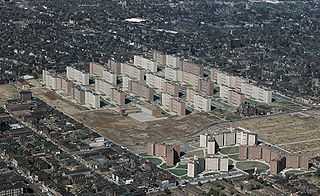Spatial mismatch

The term was first used by John F. Kain in 1968.[1] In 1987, William Julius Wilson was an early exponent, one of the first to enunciate at length the spatial mismatch theory for the development of a ghetto underclass in the United States.[2]
History

After World War I, many wealthy Americans started decentralizing out of the cities and into the suburbs. During the second half of the 20th century, department stores followed the trend of moving into the suburbs. In 1968, Kain formulated the “Spatial Mismatch Hypothesis”, although he did not refer to it by this term. In his hypothesis, he speculated that black workers reside in segregated zones that are distant and poorly connected to major centers of growth. The Spatial Mismatch phenomenon has many implications for inner city residents that are dependent on low level entry jobs. For example, distance from work centers can lead to increasing unemployment rates and furthermore dampening poverty outcomes for the region at large.
Factors of spatial mismatch
In 2007, Laurent Gobillon, Harris Selod, and Yves Zenou suggested that there are seven different factors that support the spatial mismatch phenomenon.[3] Three factors are attributed to potential workers accessibility and initiatives. The remaining two factors stress employers’ reluctance to divert away from the negative stigma of city people and in particular minorities when hiring.
Potential workers perspectives

- Commuting cost is seen as an obstacle for inner city people to be present for job interviews and furthermore to arrive to work everyday on time. In other words, cars may be too expensive for some workers and they may have to rely heavily on public transportation. Public transportation is problematic in a sense that it is not always prompt and in addition, it may not stop at all job location sites.
- Information access to jobs decreases as distance increases away from the job center. People who are living away from the job center are generally less knowledgeable about potential openings than individuals who live closer to the job center. Therefore, networking and information spillovers are of a major advantage in accessing information about potential openings.
- There seems to be a lack of incentive for distance workers to search intensively for a job that is relatively far away. Gobillion, Selod and Zenou believe that minorities more or less do a tradeoff between short term loss and long term benefits. The short term loss involves making frequent search trips to distant work centers. However, the long term benefit involves obtaining a stable job and thus a higher wage rate. Unfortunately, minorities tend to weigh the short term loss higher than the long term benefits and as a result decreases their opportunity at obtaining a job in the suburbs.
- There also seems to be a high search cost involve for urban workers looking for a job in the suburbs. This might be associated with paying a job agency to expand their search beyond the urban residential area or locating an agency in the suburbs.
See also
References
- ↑ Kain, John F. (1968). "Housing Segregation, Negro Employment, and Metropolitan Decentralization". Quarterly Journal of Economics 82 (2): 175–197. doi:10.2307/1885893.
- ↑ Wilson, William Julius (1987). The Truly Disadvantaged: The Inner City, the Underclass, and Public Policy. Chicago: University of Chicago Press. ISBN 0-226-90130-0.
- ↑ Gobillon, Laurent; Selod, Harris; Zenou, Yves (2007). "The Mechanisms of Spatial Mismatch". Urban Studies 44 (12): 2401–2427. doi:10.1080/00420980701540937.